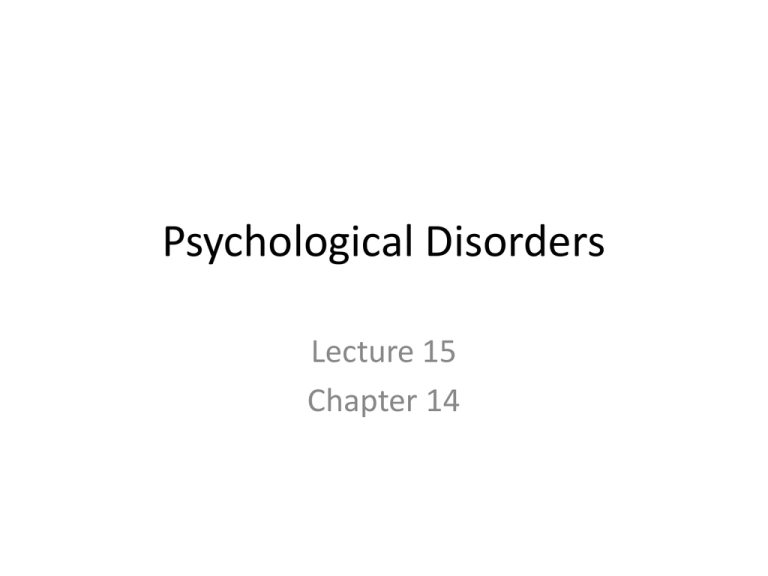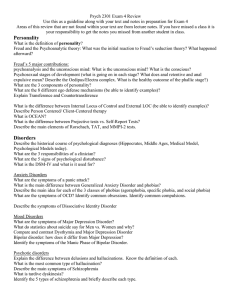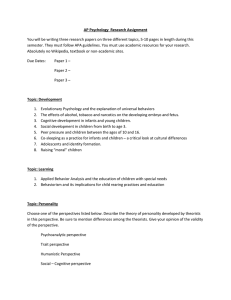Psychological Disorders Lecture 15 Chapter 14
advertisement

Psychological Disorders Lecture 15 Chapter 14 Defining Abnormality To study the abnormal is the best way of understanding the normal. William James (1842-1910) 2 Defining Abnormality Defining Psychological Disorders Is being abnormal enough to call something a disorder? 4 Defining Psychological Disorders 1.deviant behavior 2.distress 3.dysfunctional 5 The Medical Model Philippe Pinel (1745-1826) from France, insisted that madness was not due to demonic possession, but an ailment of the mind. George Wesley Bellows, Dancer in a Madhouse, 1907. © 1997 The Art Institute of Chicago Dance in the madhouse. 6 Medical Model physicians discovered that syphilis led to mental disorders 1. 2. 3. 4. Etiology Diagnosis Treatment Prognosis 7 The Biopsychosocial Approach 8 Classifying Psychological Disorders 9 Multiaxial Classification Note 16 syndromes in Axis I 10 Goals of DSM 1. 2. Describe (400) disorders. Determine how prevalent the disorder is. Disorders outlined by DSM-IV are reliable. 11 Labeling Psychological Disorders 1. Critics of the DSM-IV argue that labels may stigmatize individuals. Elizabeth Eckert, Middletown, NY. From L. Gamwell and N. Tomes, Madness in America, 1995. Cornell University Press. Asylum baseball team (labeling) 12 Labeling Psychological Disorders 2. Labels may be helpful for healthcare professionals when communicating with one another and establishing therapy. 13 Labeling Psychological Disorders 3. How should the label affect responsibility? http://www.radiolab.or g/2010/jun/28/ Elaine Thompson/ AP Photo Theodore Kaczynski (Unabomber) 14 Anxiety Disorders Feelings of excessive apprehension and anxiety. Often includes the symptom of panic attacks. 1. 2. 3. 4. 5. Generalized anxiety disorder Panic disorder Phobias Obsessive-compulsive disorder Post-traumatic stress disorder 15 Generalized Anxiety Disorder Symptoms 16 Panic Disorder Symptoms 17 Phobias 18 Obsessive-Compulsive Disorder 19 Brain Imaging A PET scan of the brain of a person with Obsessive-Compulsive Disorder (OCD). High metabolic activity (red) in the frontal lobe areas are involved with directing attention. Brain image of an OCD 20 Post-Traumatic Stress Disorder Four or more weeks of the following symptoms 1. Haunting memories 2. Nightmares 3. Social withdrawal Bettmann/ Corbis 4. Jumpy anxiety 5. Sleep problems 21 Resilience to PTSD Only about 10% of women and 20% of men react to traumatic situations and develop PTSD. 22 Explaining Anxiety Disorders Freud suggested that we repress our painful and intolerable ideas, feelings, and thoughts, resulting in anxiety. 23 The Learning Perspective fear conditioning observational learning John Coletti/ Stock, Boston 24 The Biological Perspective Natural Selection Genetic inheritance 25 The Biological Perspective Generalized anxiety, panic attacks, and even OCD are linked with brain circuits like the anterior cingulate cortex. 26 Dissociative Disorders Conscious awareness becomes separated (dissociated) from previous memories, thoughts, and feelings. Symptoms 1. Having a sense of being unreal. 2. Being separated from the body. 3. Watching yourself as if in a movie. 27 Dissociative Identity Disorder (DID) • http://www.npr.org/2011/10/20/14151446 4/real-sybil-admits-multiple-personalitieswere-fake Lois Bernstein/ Gamma Liason Chris Sizemore (DID) 28 DID Critics 29 Mood Disorders 1. Major depressive disorder 2. Bipolar disorder 30 Major Depressive Disorder Symptoms: 31 Bipolar Disorder Depressive Symptoms Manic Symptoms Gloomy Elation Withdrawn Euphoria Inability to make decisions Desire for action Tired Hyperactive Slowness of thought Multiple ideas 32 Bipolar Disorder Earl Theissen/ Hulton Getty Pictures Library The Granger Collection George C. Beresford/ Hulton Getty Pictures Library Bettmann/ Corbis Hemingway Clemens Wolfe Whitman 33 Explaining Mood Disorders Lewinsohn et al., (1985, 1998) note that a theory of depression should explain the following: 1. Behavioral and cognitive changes 2. Common causes of depression 34 Theory of Depression 3. Gender differences 35 Theory of Depression 4. Depressive episodes self-terminate. 5. Stressful events often precede depression. 6. Depression is increasing, especially in the teens. Desiree Navarro/ Getty Images Post-partum depression 36 Suicide 37 Biological Perspective Genetic Influences: Mood disorders run in families. The rate of depression is higher in identical (50%) than fraternal twins (20%). 38 The Depressed Brain PET scans Courtesy of Lewis Baxter an Michael E. Phelps, UCLA School of Medicine 39 Social-Cognitive Perspective 40 Negative Thoughts and Moods 41 Depression Cycle 42 Schizophrenia 1. Disorganized and delusional thinking. 2. Disturbed perceptions. 3. Inappropriate emotions and actions. 43 Types of Schizophrenia Symptoms of Schizophrenia Positive symptoms versus Negative symptoms 45 Disorganized & Delusional Thinking Does selective attention failure play a part? 46 Hallucinations L. Berthold, Untitled. The Prinzhorn Collection, University of Heidelberg August Natter, Witches Head. The Prinzhorn Collection, University of Heidelberg 47 Inappropriate Emotions & Actions 48 Onset and Development of Schizophrenia Nearly 1 in a 100 suffer from schizophrenia (WHO, 2002). Usually diagnosed between age 18-24 49 Chronic and Acute Schizophrenia When schizophrenia is slow to develop (chronic/process) recovery is doubtful. Such schizophrenics usually display negative symptoms. When schizophrenia rapidly develops (acute/reactive) recovery is better. Such schizophrenics usually show positive symptoms. 50 Understanding Schizophrenia Schizophrenia is a disease of the brain exhibited by the symptoms of the mind. Brain Abnormalities Dopamine Overactivity 51 Abnormal Brain Activity Brain scans show abnormal activity in the frontal cortex, thalamus, and amygdala of schizophrenic patients. Paul Thompson and Arthur W. Toga, UCLA Laboratory of Neuro Imaging and Judith L. Rapport, National Institute of Mental Health 52 Abnormal Brain Morphology Both Photos: Courtesy of Daniel R. Weinberger, M.D., NIH-NIMH/ NSC 53 Viral Infection individuals who contracted a viral infection (flu) during the middle of their fetal development 54 Genetic Factors 0 10 20 30 40 50 Identical Both parents Fraternal One parent Sibling Nephew or niece Unrelated 55 Genetic Factors 56 Personality Disorders inflexible and enduring behavior patterns that impair social functioning. •Antisocial Personality Disorder •Borderline Personality Disorder •Narcissistic Personality Disorder 57 Understanding Borderline Personality Disorder • Symptoms – Trouble regulating emotions – Quick to anger – Fear of abandonment – Impulsiveness – Rocky relationships – Suicidal thoughts and attempts Understanding Borderline Personality Disorder • Risk Factors – Genetics • Twin studies – Environmental • Unstable family Understanding Antisocial Personality Disorder • Psychopath http://www.thisamericanlife. org/radioarchives/episode/436/thepsychopath-test Take notes on symptoms and risk factors Understanding Antisocial Personality Disorder PET scans of 41 murderers revealed reduced activity in the frontal lobes. In a follow-up study, repeat offenders had 11% less frontal lobe activity (Raine et al., 1999; 2000). Courtesy of Adrian Raine, University of Southern California Normal 61 Murderer




